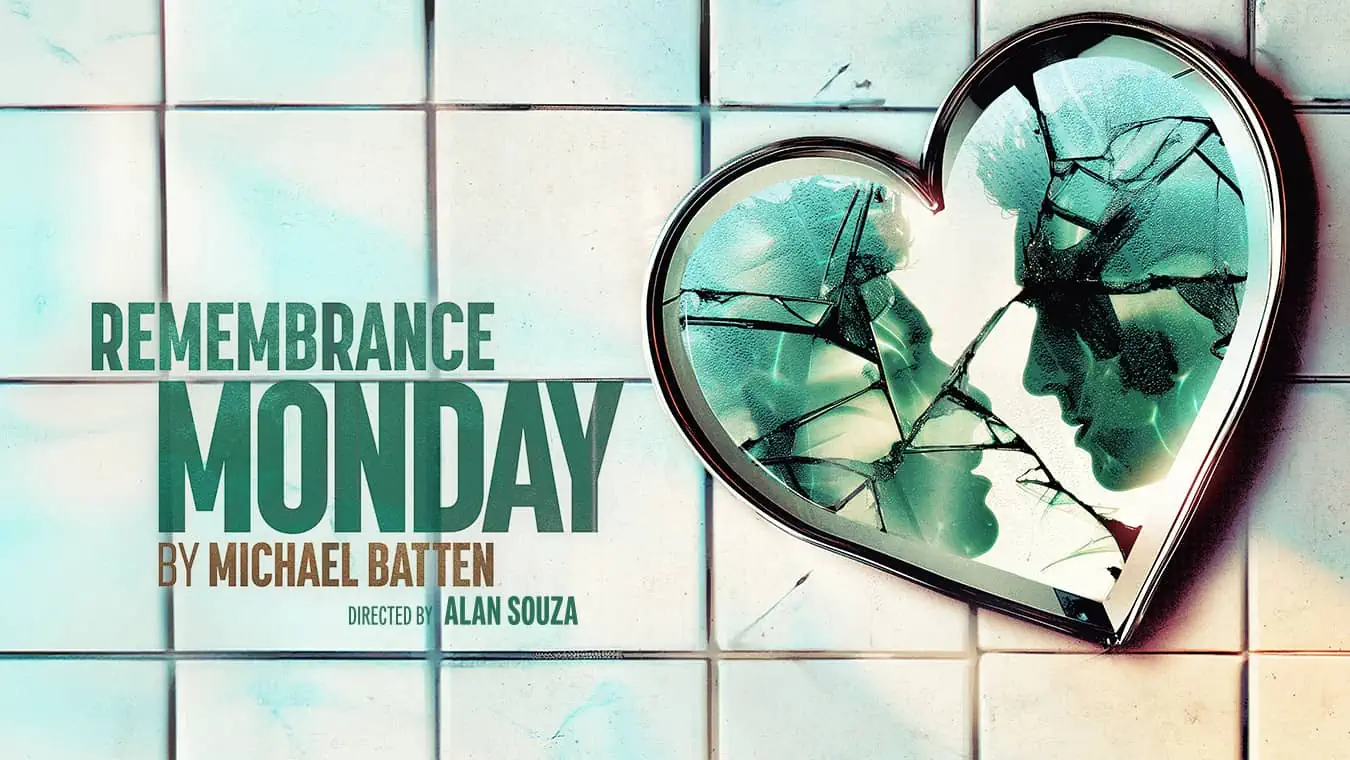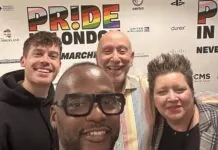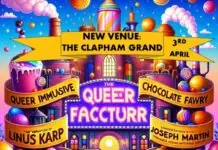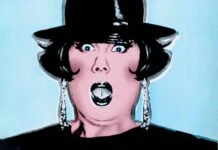Andrew Logan is a multi-disciplinary artist and the founder of Alternative Miss World
By Patrick Cash, photos by Robyn Beeche.
Tell us a bit about yourself, in your own words…
Well, I’d call my life an artistic adventure. I trained as an architect, in Oxford, in the 60s. And then I started making things in about 1968. Then I came to London in 2970, and I’ve been making things ever since. Now, I’m self-taught, and I’m kind of, as an artist in between so many different camps. Rather than just being a person, a human being, people love to identify…
What do you do?
What do you do – yes! [Laughs]. Well, as an artist I make jewellery, portraiture, monuments, performance, anything realy. I’ve always wanted to stretch the mind. And my work is really unique, there’s noone else doing – mosaic work, but not these kind of portrait things. The technique I think is quite individual. Which makes it great, but it also makes it quite difficult, because people like to identify – so if they’re going to see something they like to know if it’s conceptual art or part of the YBA, or something.
What got you into experimenting with art in the first place from architechture?
Actually I had an acid trip. I’ve only had one! But it completely changed my idea of reality. It sort of gave me the confidence as well, because I wasn’t very confident about doing things. So I always feel very much for young people, because there’s a part where you’re growing up… But you need something, it could come from a person, it could come from a place, it could come from a drug – but you need that little prompt that then allows you to take a path, and then it becomes very clear. But it is getting through that little *noise*. So that’s how I started really, and then I had this idea of another reality and then I just started to make things.
Do you think needing that spark is because as a society, we live in a meritocracy, and there’s all this thing of ‘we have to be better than one another’ so we’re kind of taught to laugh at self-experession, which is why we tend to keep it inside.
Of course. Well you’ve only got to look at children, and their art is fantastic and then sort of around puberty time it sort of closes up and clamps. And it’s gone. It’s not gone, it’s still there – everyone has it – but it’s just as you say a meritocracy we live in that sort of society. I kind of waved my way through it.
I’m working on this article at the minute about gay men and the selfie. Because you know they use the selfie on social media as a way to express themselves but its just the physical, it’s just a veneer, there’s this lack of inner expression… And how did you get into sculpture particularly?
I’d worked as an errand boy for an exhibition called cybernetic serendipity, at the ICA which was a really ground-breaking exhibition; it was about robots and computers. And this was 1960-something, ’68 or ’67, so computers didn’t exist. Well, they did, but they were these huge machines – and I was the errand boy on that. And then she gave me a exhibition when I left college in 1970, called 10 sitting rooms, and 10 young designers, artists were asked to create an environment. We were given £100 each and you could do anything you wanted. So I sort of brought the countryside to city, I made cotton wool clouds with lights in them and then I painted the walls blue, and artificial grass all over the floor and then I covered a cocktail cabinet with grass, I had a wind-up record player, and then I had a hill with a waterfall that came down into a lake, a little pool. There’s huge giant fertileries, over that, and I had a dead horse that was the setee and I served tea. And that was the beginning of it really.
Sounds beautiful…
So I started really quite big environments, big things. Practically speaking, I’ve still got Gold Field which I’ve taken up to the men in Wales, it was at Whitechapel Art Gallery, 1976, and it was a field of golden wheat which was 15 foot high. So you were like a little mouse going through this field of wheat. That’s how I started but it’s practically not possible… At that time, museums and galleries didn’t buy environments or installations – they didn’t really exist. People did painting or performance. But actually installations, no. So anyway I kept this, I’ve still got it – it’s lost a few of its wheat, but it’s still there. And then I started to, portraiture was about 78, I’d been to Egypt in ’77 and then came back and done a whole sonar lunar exhibition, which is in the museum in Wales. Which was related to my friends, so portraits of my friends but also related to the Gods of Egypt. And then ’82 I went to India with Zandra Rose, where I started these masks – they had these fantastic masks – and this whole thing about the human face. And then it kind of evolved from there, and then I started doing a lot more portraiture. And it’s really, I’m sure this big change that’s about to happen, I’m sure something else is going to come from the work. But the only way you can do that is by change, you can stay in the same place forever and it doesn’t change.
You need to have the impetus?
You’ve got to have the impetus. Exactly, yeah.
In your first installation at the ICA what was the symbolism of the dead horse, was it about the cycle of life and death?
No, in fact I can tell you exactly why it was, a friend of mine was working on ‘Charge of the Light Brigade’, he was working on the design area and they had these latex horses they fill with straw and then they blow them up. When you see Charge of the Light Brigade and these horses going ‘brrrp’ it’s latex, and they had a whole lot left over and they said ‘do I want one?’ and I said ‘I’d love one’. So that’s how my work happens: other people read all these implications and ideas into them afterwards but really it’s very simple and of course you look at the horse and it’s marvelous for sitting on, perfect as a settee. And that’s how it happened.
And when did you come out as gay?
Goodness. I think that evolved as well. I had girlfriends when I was at college and I suppose when I came to London I began to meet gay men and it was from there. I actually met Michael in 1972 and we’ve been together ever since, which is perhaps why we’re still here, and all my great friends Derek and Bill and so many gay friends went because of AIDS, and I was monogamous. So that’s always been us, so I suppose I’ve been very lucky, because I survived. But again, it evolved. It’s funny, my parents they were from the old school, we always talked about it but they knew that, they knew and my partner Michael and I lived together but it was kind of unsaid. Which was actually very nice, it didn’t really matter – I certainly wasn’t going to come out as gay or anything, it didn’t seem to be relevant really. They loved me and I loved them and I carried on with my life and they carried on with theirs… I remember once or twice, some neighbours would say to me ‘when are you going to get married?’ and my father would say ‘it’s his choice what he does with his life’ so he knew and he was protective as well. It was nice. And I came from a large family of five brothers and a sister, so again it was very natural. And then you can evolve as a human being as well.
How did you meet Michael?
Gosh. I met Michael because I was living off Kingsland Road in Dalston, it was a wilderness then, Judy Morays was his girlfriend and he was living around the corner in De Beauvoir square. And I knew Judy through a mutual friend and so she asked me to come round because I didn’t have any money to come for dinner. So we met and then it was consummated when he was living in a Thames barge right outside where Turner did his watercolours right in Chelsea, and it was his birthday on July 8th, and we met and I stayed a few days and that was it, we’ve been together ever since.
That’s quite an interesting issue right now, with a lot of people talking about how gay marriage has come through, and certain gay men of an elder generation are talking about how gay men are meant to be polyamorous and they’re meant to have a fluid sexuality – has it been hard to keep a monogamous relationship going?
Not at all, no. And I think each individual differs, I think we’re all different and some people do need – in heterosexuality there’s still marriages where they throw themselves around and I’ve been very direct in my life and very dedicated. You have to work at it, in a relationship whatever the relationship is, you really have to work. And also to be apart is very important – like I’d go to India for three months and we’re born in the world by ourselves and we’ll go out by ourselves, unless you have a suicide pact, but I suppose that’s different isn’t it? So I feel we are individuals even though we have loving relationships so yes, it’s a curious thing all that, I suppose it’s so natural for me I’ve never had to worry about it. I can understand for other people it’s really difficult.
Obviously in your case it was just a question of meeting the right person…
Yes.
Maybe at the moment with the gay scene and Grindr it becomes more difficult and there’s always a feeling of ‘the grass is greener’ etc.
Yes, and the Alternative Miss World is for everybody, young, old, sexual preference, it doesn’t matter, you’re a robot one year, and it’s open to everyone. A lot of gay people come because they have a lot of gay friends, and they get the humour because it’s all about fun really, but there’s no emphasis on one or the other, I just think that gay men are possibly more sensitive really. That’s what it’s about.
How do you see London’s LGBT community today and how do you see it as having evolved since you came onto it?
Well, it has evolved hasn’t it? There wasn’t anything like that when I – and I think there’s a film called The British Guide to Showing Off and I believe it must have been 1991 when Thatcher brought in some law, which I wasn’t even aware of, evidently. And I contradicted everything she said, I’d just gone and done this event, but that’s very much – I’m very direct in my life, I want to create events and just celebrate life really. It’s so sad we haven’t got more time because really we come here, we go there, and there’s a gap inbetween and what do we do? But the pressures are so immense these days – capitalism really doesn’t work, I mean truthfully, material possessions that’s not the way, and socialism isn’t either. But I was in Russia in the 90s when there was a gap and it was fantastic, you could go anywhere, parties all the time, there was a sense of freedom, because capitalism hadn’t come in and communism had finished so there was this hole and as I said to identify with the political system, they still liked to identify or a religion, the big things seems to be religion now… Eugh. I mean I’m a very spiritual person but any organised religion I have no interest in at all. Look at the damage they’re doing.
So let’s talk about Alternative Miss World, how did it come about?
I’d been to Crufts Dog Show. And you’ve got to remember that Miss World at that time in the 70s was huge and people went to work or went to the pub in the evening or stayed at home and watched TV. And so it was a very big thing and I of course was aware of it, and the whole farcical thing about it, and it did seem rather unpleasant but anyhow I liked the format very much, so that’s how it all started in my little studio in Hackney in Downham Road to 100 people… Daywear, swimwear, eveningwear, we did that, and we created some alternative crown jewels and we had an MC, a friend of mine did the MCing and both men and women dressed up in outfits and that was the beginning and then the following year it got even more popular – the same studio, more people. That’s when I had all the fashion designers and that’s when Derek (Jarman) shot it on his camera. I was great friends with Derek and even collaborated with him on some of his super 8 movies, I think some of the first movies he did were at Downham Road. So, we had fun. Even Derek, he was very serious, he’s now a legend but he was fun, he liked having fun. He smoked dope and he drank – not drank so much, Derek didn’t drink a lot. He just loved having a good time.
And who won the first one?
Patrick Steed, a friend of Derek’s. And they co-wrote, evidently, Sebastiano together, Derek’s first movie and they fell out over it. Derek had many fallings out, he was rather dramatic, and Patrick sadly was one of them. He came as Miss Yorkshire, and I remember his evening wear, he had his ordinary boots on and his hair tied back in a ponytail and he had red lips, that was all, and he had a sort of red crochet outfit and on his head he had a plastic coffee cup… Well I think it was the plastic coffee cup that got everyone’s imagination and of course in the early 70s they were very unusual, vending machines and things were just in their infancy, and he was very good. He eventually lived in New York and then he died I think, something happened, but he separated from Derek which was sad. He was a very interesting man, a writer.
What do the contests have to do at Alternative Miss World?
Well they have to do daywear, swimwear and evening wear, three outfits, and then in the evening wear they have the oh-so-important personality interview and that’s basically it.
Are you the judge?
No, no, we have judges, and the first year David Hockney was still in town before he went to America, so David came along, there was a man called Robert Medley, who was a wonderful painter who taught Derek at the Slade, and Ben Lambert who was an Australian, who was an amazing man of fashion who kind of inspired Karl Lagerfield etc, much later on, he was an extraordinary man. Quite wonderful minds: it was just people I knew. It still is really, I thought – my judges tend to be people I know really and it’s very much about the contestants, but now we live in an age of celebrity, everybody wants to know who the judges are, no one asks who the contestants are.
How do you get the contestants?
Well, it’s just people – my sister’s done it every time, Janet. She’s done every one, she came third the last time. Then we’ve got Quentin, my youngest brother Quention, he comes from Norfolk and he’s part of a troupe called the Kit Witches, they’re an ancient troupe and they all come to do Morris Dancing and alternative morris dancing style and they’re coming, and I think my brother Richard who very early on in the 70s, did the staging every time and my brother Peter did the music and my sister entered every time and my mother when she was alive, I think she judged a couple of them, so yeah, it was nice. Because it is a family really.
Where did the other contestants come from? How many contestants are there?
Some people know about it, we were very restricted now with time, because The Globe I think it starts at 7 and we have to finish by 11, you can only have so many contestants. In 1981 when I did the Cecil B. DeMille one which was at the Grand Hall Olympia where the catwalk was 250 feet long, and it ended at 3 in the morning and we had 25 or 30 contestants or something and they turned the music down, they turned the heating off and most of the people had gone home, but it didn’t matter, it was fabulous. It was a magnificent, incredible one, it was where we lost lots of money, because it’s all very much people just do it for the love of it. And now, you can hear people through the next door, they’re here because they want to help. It’s very much that kind of event, which is rare again, just because of the constrictions of the city we live in now everyone has to work 26 hours a day just to survive and that’s very sad because what it doesn’t allow for is that little gap of creativity which we spoke about earlier. You need to have little gaps to get the creative juices going, and if you don’t get them and you’re just pounding on and pounding on, where are you pounding on to? At the end of it, even if you have all the money in the world and all the fame and fortune, we’re all going to go the same way, so why not have a nice time on the way?
Why do you think the Alternative Miss World picked up so much momentum and attention?
Well it was very alternative and you know I’m very lucky, I know some very interesting people, I suppose it’s been my life really, artistic adventure, I really am interested in artists. But there weren’t many artists then – now of course there’s thousands and thousands, but it’s good, means there are a lot more cognitive things going on, but I suppose I knew Derek and Derek won 1975 as Miss Crepe Suzette –
Oh yes, I saw that in the Somerset House exhibition on Jarman –
Yes. So we didn’t know that Derek would be – I mean Derek had always wanted to be a famous filmmaker and even though he died young, he did get what he wanted. He wanted to be well-known and he wanted to be, and now of course it’s gone even more, but it was wonderful that he achieved what he wanted. Because when I first met him it was through my brother Peter who was a student at the Slade, and then really I suppose I’m very privileged in that I know a lot of interesting people. I’m still magnetized by interesting people –
And you whirl them around and bring them together? It all comes to a zenith with you… What was Derek like when you first met him?
Derek was wonderful, he was very English and talked a lot, he had wonderful manners, I remember how he walked and talked, full of ideas, very enthusiastic, always with young boys, well I suppose he was young then, but he always had a court. It’s a bit like David Edge, he always has a court, there are certain people who always have a court around them, I don’t know if that happens nowadays. They just because of their magnetism they just attract, so he always had people round, always. Which was lovely and then we always had fun together, because kind of in your twenties you had time for each other and at that time we did. That’s how Alternative Miss World happened, because we were all sitting around chatting and the idea came up.
Fantastic. What are some of the most scintillating stories you have to tell from Alternative Miss World over the years?
There are so many, but I’m sure everyone would like to know about Divine… He was divine, he was wicked, but he was divine. He was a wonderful performer, he just captured something that was just quite unique and he always said he wanted to be my weight and stuff himself with cushions but sadly he never got there because he died of an enlarged heart actually. The heart had grown in proportion to his body and we have a cavity around the heart and the heart was too big, it just couldn’t beat, so he died of a big heart. But he arrived at the Circus Tent, Clapham Common, and I remember his entrance so well as my brother Peter was doing the music and someone got muddled up, so when Divine came to the top of the staircase there was no sound, but he just grimaced and stroked his crotch and waved his wig and anyway it was amazing, the crowd went wild. I remember asking him, saying, ‘now Divine, do you have any tips for us here?’ and he said ‘yes: eat! Eat! Eat!’ That was a wonderful night.
Was John Waters there?
John was very much part of America and since then he’s digressed and he’s become both an artist and showing his works and he does performance and all sorts of things but at that time Divine had come over because his career was lapsing a bit in America, he’d met somebody here, who said he’d be his manager and he sort of became a disco star. My sister Janet actually was his rodie, and as she always said, she’d have to go to these really sleazy gay clubs and it was always ‘no dough, no show’. And she went to some amazing places and Divine would appear and he built his career up as a pop star, so 78 was just the beginning of that, I met him in 77, when he came over to do ‘Women Behind Bars’ with Fiona Richmond in the Whitehall Theatre and he was fabulous.
Was he nice as a person as well?
Oh yes, our birthdays were actually only a week apart, I’m on the 11th and he must have been the 18th, just a week apart. So he actually died 27 years ago. We were very close and he only had a very few friends in the UK, but he became a great anglophile, and there’s a film called ‘Divine’ I believe now that doesn’t embrace any of that side of his life at all, which was very interesting as a matter of fact. America of course was the formative years but his English side because he spent the majority of his time in the latter part in UK.
And what are you expecting from this event coming up?
Well surprises, because I know some of the contestants who have entered but I have no idea what they’re coming as. And we’ve got Grayson Perry, he’s the co-host, he came round the other night and explained he was having a truck to bring his three outfits, I said ‘Grayson you’re not to the upstage the contestants’ but I’m sure it’ll be all in fun. We’ve got people flying in from Australia, America, India…
And this is the first time you’ve done it in…
Five years. Five years, and I’d been through all the elements, air, fire, water, earth, void, and then the elements themselves, and I’d done the universe, and it was numbers as the theme this year because I think I was attracted to digital and then we got the site that the Globe offered us, which was fabulous because nothing ever happens in the Globe as you know, it can be things relating to Shakespeare but this is something completely different. But I do realize in fact that it’s about the people’s theatre, that’s what the Globe is about, and that’s what this event is, it’s for people. If I had a choice, I’d have it free, no charge, and big, yes, but I think things can get too big. When we did the Roundhouse we had 2 and a half thousand people there, this is down to 1 and a half now, and we’ve sold out and there are so many people now who are wanting tickets and can’t get in, and I feel awful because I’d love them to be there and up to now it’s been quite easy to do that, but The Globe and neon, the complete opposite of Shakespeare and brown and Elizabethan. We’ve got 16 contestants this year, it was 17 but 13 isn’t happening. And we’ve got judges like Fenella Fielding, and Rebecca Eno, and my brother Peter, and a lovely lady called Rebecca Hothburger who runs a great museum in America named the American Museum of Visionary Art, you should google it. It’s for outsider art, and she’s a great fan of mine and has a lot of my work there. And I wanted to get hold of John actually but didn’t have his email and this is what happens – social media can be so easy but it’s quite difficult at the same time if you haven’t got the right number or dot… And then to find it, because I like the thing to be easy and to really evolve by itself. When I start the event I always start by building the crown, that’s the first thing I do, I build the crown and then from that everything happens from the crown, it all evolves and everything comes from the crowd. And then we have a crowning, I love crowning, anything to do with ritual, there’s not enough of ritual nowadays. Too much shopping, we need a bit more ritual. And that’s what this event is about. It’s about having fun and celebrating life, and it’s very unusual: organized chaos. A surreal art event for all-round family entertainment, that’s how I describe it, in a nutshell.











